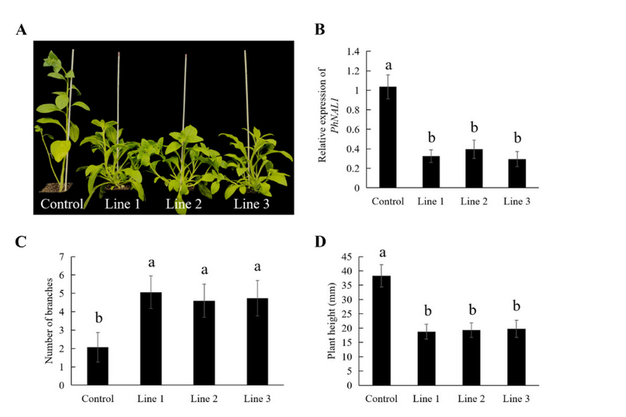According to the American Society for Horticultural Science, branching is a pivotal determinant of plant architecture, not only influencing the capacity of the plant to adapt to its environment but also significantly impacting crop yield, ornamental characteristics, and production economics of horticultural plants. " Delving into the molecular regulation mechanisms governing shoot branching holds significant theoretical and practical importance," they say. Phenotype analysis of petunia plants. (A) Comparison of the phenotypes of control and PhNAL1 RNA interference (RNAi) plants. (B) Quantitative real-time polymerase chain reaction (qRT-PCR) was used to detect PhNAL1 transcripts in the total RNA of leaves. (C) The branch numbers of the control and transgenic plants (line 1, line 2, line 3) are displayed (n = 15). (D) The plant height of the control and transgenic plants (line 1, line 2, line 3) are displayed (n = 15). Bars with different letters indicate significance at P ≤ 0.05.
Phenotype analysis of petunia plants. (A) Comparison of the phenotypes of control and PhNAL1 RNA interference (RNAi) plants. (B) Quantitative real-time polymerase chain reaction (qRT-PCR) was used to detect PhNAL1 transcripts in the total RNA of leaves. (C) The branch numbers of the control and transgenic plants (line 1, line 2, line 3) are displayed (n = 15). (D) The plant height of the control and transgenic plants (line 1, line 2, line 3) are displayed (n = 15). Bars with different letters indicate significance at P ≤ 0.05.
"Petunias, belonging to the Solanaceae family, are not only beloved in gardens but also serve as model organisms for studying plant development due to characteristics encompassing a well-defined genetic background, a brief growth cycle, and a well-established transformation system.
The study explores the genetic factors influencing the branching patterns of Petunia plants, with a specific focus on the PhNAL1 gene. The discovery of PhNAL1's involvement in branch development not only deepens the understanding of Petunia biology but also has broader implications for the field of plant genetics and horticulture.
This breakthrough brings scientists another step closer to deciphering the genetic code that dictates the form and structure of Petunia plants. Understanding the role of PhNAL1 in branch development opens up new possibilities for targeted breeding and genetic engineering, allowing for the subsequent development of new cultivars of petunia endowed with distinct branching characteristics," they add.
Xinyi Deng is an Associate Professor at Anhui Agricultural University Department of Ornamental Horticulture Baoding, People's Republic of China.
The full article can be found on the Journal of the American Society for Horticultural Science electronic journal website at: https://doi.org/10.21273/JASHS05331-23
For more information:
American Society for Horticultural Science
ashs.org
